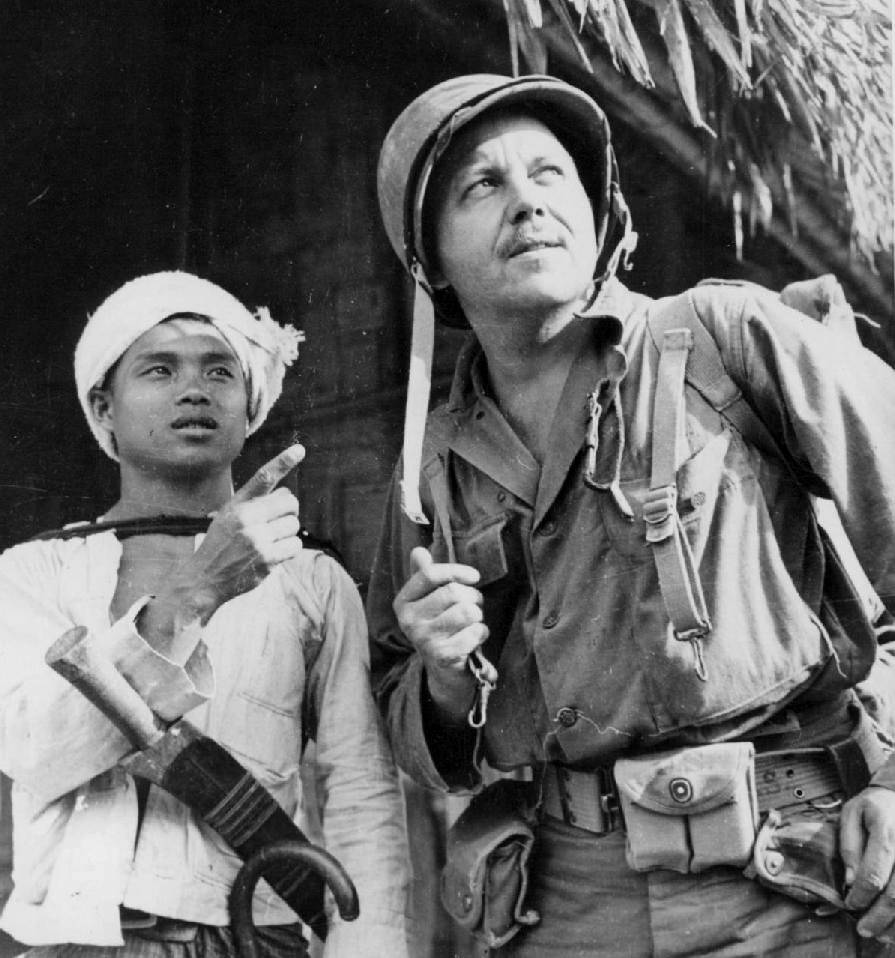
World War II: Burma--The Kachin People

Figure 1.--Many of the Burmese people recognized the Japanese as liberators. Many of the Hill Tribes, however, opposed the Japanese because of their brutality. The most stridently anti-Japanese group was the Kachin people in northern Burma. This was an area of special interest to the Americans who wanted to reopen the Burma Road. The press caption here read, "U.S. correspondent in Burma: United Press correspondent Frank Hewlett, talks with his guide, a Kachinnative, (left), 'somewherev in Burma,' where Hewlett went into action with the first U.S. infantry to fight in this area. Passed by sensors.)" Notice the Kachin knife and very British umbrella. The photograph was dated April 6, 1944."
|
|
The Kachin or Jingpho people inhabit the Kachin Hills in northern Burma and neighbouring areas of China and India. They are called the Singpho in India where they are found in Arunachal Pradesh. As is the case for many Burmese ethnic groups, the Kachin are a composit grouping of several related tribal groups. They were known for their fierce independence, disciplined fighting skills, and complex clan inter-relations. Many Kachin's embraced Christianity. These attributes and jungle skills made them invaluable adjuncts for the Allies attempting to drive the Japanese out of Burma. The Kachin inhabited northern Burma. Considerable missionary work took place during the British colonial period. The Kachin were ardently anti-Japanese. This reflected their generally pro-British attitudes and conversion to Christianity. It also reflected Japanese brutality. They were better placed than the Karen who were also anti-Japanese. The Kachin were located in an area where the Allies could get weapons to and provide miklitary trainung. The Kachin were in the north on the Chinese and Indian borders. Thus the Allies were able to supply weapons and orgnized and trained the Kachin Rifles and Kachin Levees to harass the Japanese. The United States was especially interested in northern Burma with the goal of reopening the Burma Road. What was to become the Office of Strategic Services activated Detachment 101 (April 14, 1942). They were given the assignment of organizing action behind enemy lines in Burma. This was the first American unit of its kind. The objectives were to gather intelligence, harass the Japanese, identifying targets for air attack, and rescuing downed Allied airmen. The American OSS personnel was never larger than a few hundred men. Insted they relied on support from anti-Japanese tribal groups, especially the Kachin. Eventually the support of the Kachin played a key role in retaking northern Burma so the Ledo Road which originated in India could be built across northern Burma to join up with the Burma Road. This restablished a land route to supply the Chinese.
HBC

Navigate the Boys' Historical Clothing Web Site:
[Return to Main Burma World War II page]
[Return to Main World War II country page]
[Return to Main Burma page]
[Biographies]
[Campaigns]
[Children]
[Countries]
[Deciding factors]
[Diplomacy]
[Geo-political crisis]
[Economics]
[Home front]
[Intelligence]
[Resistance]
[Race]
[Refugees]
[Technology]
[Bibliographies]
[Contributions]
[FAQs]
[Images]
[Links]
[Registration]
[Tools]
[Return to Main World War II page]
[Return to Main war essay page]
Created: 6:23 AM 9/12/2012
Last updated: 10:57 PM 9/12/2012



